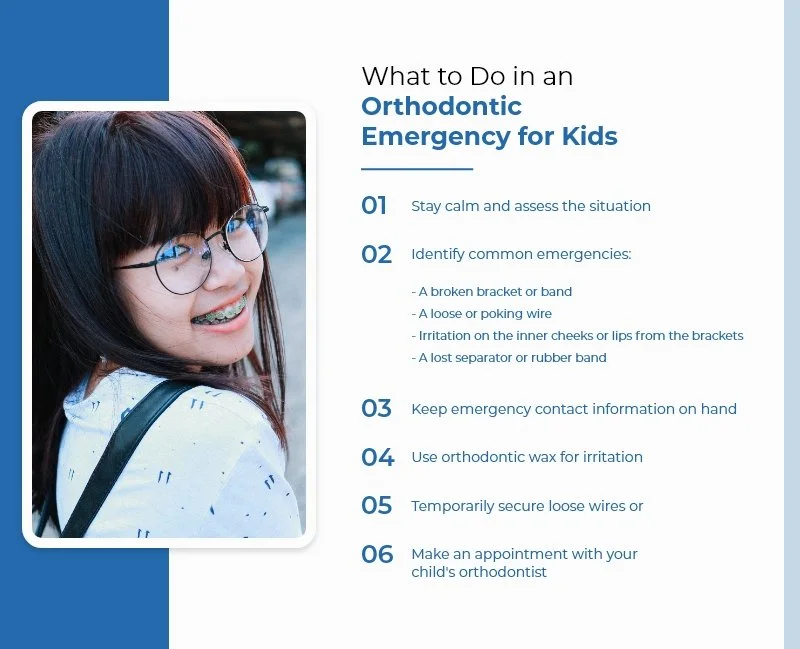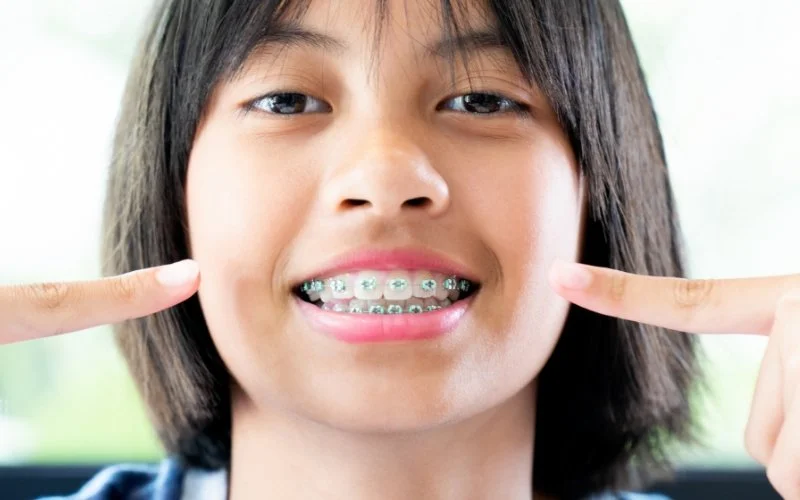How to Prepare, Support, and Reassure Your Kids When Getting Braces
Getting braces can be a big step for kids—and just as nerve-wracking for parents. Whether it’s the fear of discomfort, changes in routine, or simply the unknown, children often need reassurance, guidance, and a bit of encouragement. If you're navigating orthodontic care for children in Singapore, this guide offers practical tips to help you prepare your child, manage expectations, and support them every step of the way.
Key Takeaways
Help your kids understand the importance of getting braces by focusing on benefits that matter to them, like easier brushing or feeling more confident about their smile.
Braces treatment can last between 1 to 3 years. Explaining the timeline and process early on can help your child stay patient and motivated.
Encourage consistent brushing, flossing, and post-meal care to keep braces clean and prevent issues.
Talk your child through what to expect at check-ups and adjustments to ease anxiety and build trust in the process.
Tightenings can cause mild soreness. Soft foods, cold compresses, and reassurance go a long way in helping your child manage it.
Knowing what to do in emergencies is essential. Keep orthodontic wax, contact info, and basic tips on hand to manage minor issues like poking wires or loose brackets.
Your involvement—through reminders, encouragement, and even small rewards—can make a big difference in your kid’s experience with getting braces.
How to Help Your Child Understand and Embrace Braces
While many kids may feel excited about getting braces—especially if their friends are wearing them—others may feel anxious or unsure about what to expect. As a parent, your role is to guide them through this transition by helping them understand the benefits, addressing their concerns, and preparing them for the changes ahead.
Helping Your Child Understand the Benefits of Braces
While braces play a key role in supporting long-term dental health, it can be challenging for children to fully understand why they’re necessary. Focusing on the benefits that are most relatable can help kids feel more open to the idea of getting braces.
1. Explain the Benefits in Simple, Tangible Terms
When talking to your kids about getting braces, it helps to keep things clear and relatable. Rather than focusing on the technical details, it may be more impactful to explain the consequences of not seeking treatment instead.
For example, instead of telling your child, “Crooked teeth can lead to gum disease due to plaque buildup”, you might say:
“If your teeth are too close together, it’s harder to brush properly, and that can lead to more toothaches.”
“Food can get stuck more easily in your teeth, which can make your breath smell bad or hurt your gums.”
“If your bite isn’t right, it can be uncomfortable to chew your favourite snacks."
When your kids can relate the benefits (or consequences) to their everyday experiences, they’re more likely to feel motivated about starting treatment.
2. Highlight the Positive Impact on Self-Confidence
Children are often very aware of their appearance, especially in social or school settings. A crooked smile can make them feel hesitant to speak up, smile in photos, or even laugh freely around friends.
For children who are particularly sensitive about how they look, it can be helpful to focus on how braces gradually change the way their teeth appear over time. Let them know that many kids start to feel more comfortable and confident as they notice the difference. Highlighting this aspect can make getting student braces feel more relevant and appealing to children who may already be thinking about how their smile affects their day-to-day lives.
3. Normalise the Experience
If your kids are feeling unsure or nervous about getting braces, one of the best things you can do is show them they’re not alone. You might mention a classmate, cousin, or older sibling who has worn braces, or point out familiar public figures or celebrities who have had experience with braces as kids. Some children even find comfort in watching short videos or stories online of others sharing their own braces journey. Knowing that others—especially people they admire—have been through the same experience can make getting braces feel less intimidating and more familiar.
The Importance of Setting Realistic Expectations
After explaining the benefits, the next step is to help your child understand what to expect. Setting realistic expectations is one of the best ways to reduce anxiety and promote a more positive attitude towards treatment.
1. Walk Them Through the Process
Children often feel more at ease when they know what’s coming. Walking them through the steps involved in getting braces can help reduce uncertainty and make the experience feel more manageable. You can explain it simply, such as:
Initial consultation: Visiting the orthodontist for an assessment to check how their teeth and bite are developing.
Taking records: This may include X-rays, photos, or intra-oral 3D scans of their teeth to help plan the treatment.
Fitting the braces: The orthodontist will carefully attach the braces to your child’s teeth. While the process itself is painless, your child may feel some tightness or discomfort afterwards. Rest assured, this sensation is completely normal and usually fades within a few days as they adjust to the new feeling.
Regular check-ups: They'll return every few weeks to have their braces adjusted and to check on progress.
The end goal: Once their teeth have shifted into improved alignment, the braces will come off, and they may be given a retainer to help keep everything in place.
Keeping the explanation clear and age-appropriate helps kids feel more prepared and less anxious about getting braces.
2. Managing Discomfort with Braces
Braces can cause some soreness, especially after fittings or adjustments. Let your child know that discomfort is normal and temporary. Reassure them that you’ll be there to help manage it with soft foods, orthodontic wax, or a cold compress. Make sure to frame it as something they can handle—and that you’ll face together. This will help them feel more supported, less anxious, and more in control of their experience, knowing that they’re not going through it alone.
3. Inform Them of the Treatment Timeline
Treatment doesn’t happen overnight. Both braces and clear aligners—such as Invisalign First, designed for kids—usually need to be worn for one to three years, depending on the individual treatment plan. For most children, this can feel like a long time, especially when they’re eager to see quick results. However, it’s important to explain that braces work slowly and steadily to shift teeth safely, and that every small change adds up over time. Setting this expectation early on can help your child develop patience and stay motivated throughout their braces journey.
4. Help Your Child Build a Daily Care Routine
Braces require consistent and thorough daily care to keep teeth and gums healthy throughout treatment—something that many kids may find challenging when they first get braces. As a parent, you can guide your child in building a routine that works for them, perhaps by brushing together in the evenings using tools like an interdental brush or setting gentle reminders. Gentle encouragement and practice are key here.
5. Adjusting Everyday Habits
Wearing braces often means changing daily habits. Certain foods—like popcorn, chewing gum, or hard snacks—may need to be avoided to prevent damage to the braces. It’s helpful to talk through these changes early on so your child understands what they can and can’t do and why these adjustments are necessary.
A Guide to Supporting Your Child’s Comfort During Treatment
How to Build a Braces-Friendly Routine With Your Kids
For kids getting braces, having structure at home and parental support can make a big difference in how they manage daily care and cope with these new experiences.
1. Morning and Night Cleaning Routine
Encourage your child to brush their teeth thoroughly in the morning and before bed. This includes brushing around the brackets and along the gumline, as well as using interdental brushes or floss threaders to clean between the teeth. These routines help prevent plaque buildup and keep their braces in good condition.
2. Post-Meal Care
Food particles can easily get trapped in braces during meals. Teaching your child to rinse their mouth or brush gently after eating can prevent discomfort, reduce the risk of cavities, and keep their breath fresh.
3. Preparing for Appointments
Going to the orthodontist regularly is part of the journey. Help your child feel more confident by explaining what will happen during each visit—whether it’s a check-up, adjustment, or cleaning. Choosing an orthodontist for kids can also make a big difference. A child-friendly dental professional will know how to communicate clearly, ease any fears, and create a more comfortable, supportive environment for your child.
4. Incentive-Based Progress Tracking
Since braces are such a long-term commitment, celebrating any progress is essential for keeping your child’s motivation high. Consider setting small goals—such as brushing consistently for a week or completing a check-up—and rewarding your child with something simple, like a sticker chart, a favourite treat, or a fun weekend activity. These small wins help keep children engaged and proud of their progress.
Braces Tightening: What to Expect
Kids getting braces will have to go in for adjustment appointments—often referred to as “tightenings”—every 4 to 8 weeks. During these visits, the orthodontist will assess how your child’s teeth are moving and make the necessary adjustments to the wires or bands.
Although these appointments are essential for keeping treatment on track, it is common for patients to experience increased pressure and soreness afterwards. This can be uncomfortable for your child and understandably worrying for you as a parent. Here are some ways you can help ease their discomfort, especially within the first 24 to 48 hours:
Offering soft foods like mashed potatoes, noodles, or bananas.
Providing a cold compress to soothe sore areas.
Using over-the-counter pain relief if needed, following the dosage instructions.
It’s also a good time to remind your child about the importance of brushing gently but thoroughly. After an adjustment, teeth can be sensitive, and plaque can easily build up if cleaning is avoided. Consistency is key to keeping both their braces and oral health in good condition.
What to Do in the Event of an Orthodontic Emergency
While serious orthodontic emergencies are rare, minor issues can and do happen. As parents, knowing how to respond calmly and confidently can help keep your child comfortable and prevent the problem from getting worse.
1. Stay Calm and Assess the Situation
Your reaction plays a significant role in how your child reacts. If a wire is poking or a bracket has come loose, do not panic—try to stay calm and focus on reassuring your child. Take a moment to gently examine the area, note the issue, and decide whether immediate attention is needed.
2. Identify Common Emergencies
Some common orthodontic issues include:
A broken bracket or band
A loose or poking wire
Irritation on the inner cheeks or lips from the brackets
A lost separator or rubber band
While these are usually not urgent, they should still be addressed promptly to prevent further discomfort.
3. Keep Emergency Contact Information Handy
Have your orthodontist’s contact details, including phone number and clinic hours, easily accessible, whether saved on your phone or written down at home. This is essential information to have, especially if this is your first experience with kids getting braces. Quick access to professional support can make these unexpected situations less stressful.
4. Use Orthodontic Wax for Irritation
If a wire or bracket is rubbing against your child’s cheek or gum, orthodontic wax may help reduce irritation. Roll a small piece into a ball and place it over the area—this can act as a temporary barrier until your orthodontist can address the issue.
5. Temporarily Secure Loose Brackets or Wires
If a wire is sticking out or a bracket feels loose, you can try gently repositioning it with a clean cotton swab or covering it with orthodontic wax to prevent further discomfort. These are temporary measures to keep your child comfortable until they can be seen by their orthodontist for proper care.
Frequently Asked Questions
1. What are the different options available for kids interested in getting braces?
There are a few types of orthodontic appliances commonly used for children, including traditional metal braces, ceramic (tooth-coloured) braces, and clear aligners like Invisalign First. Each option has its own advantages, depending on your child’s dental needs, age, and daily routine. A qualified orthodontist in Singapore can guide you in choosing the most suitable treatment for your child.
2. Are there any activities my child should avoid while wearing braces?
Yes. If your child plays contact sports, it’s important they wear a properly fitted mouthguard to protect both their teeth and braces from injury. When it comes to food, hard items like nuts, popcorn, or ice, and sticky treats like chewing gum or toffee should be avoided, as they can damage brackets or bend wires.
3. Is there an ideal age for kids to get braces?
There isn’t a fixed age for starting braces, as it depends on each child’s dental development. However, many orthodontists recommend having an initial evaluation by age 7. At this stage, the orthodontist can assess how the teeth and jaws are developing and identify any potential issues early. This does not always mean treatment will start immediately, but it helps with planning the right approach at the right time.
Conclusion
For most kids, getting braces is a significant adjustment. But with the right preparation and support, you can help your child feel more at ease as they adapt. By staying involved and encouraging daily care routines, you’re guiding your child through a process that promotes awareness and responsibility for their oral health—both now and in the years to come.
If you’re looking for a child-friendly orthodontic treatment in Singapore, Align Braces Clinic is here to support your family. With a dedicated team of orthodontists experienced in treating kids, and an approach designed to put children at ease, we aim to make each visit as smooth and reassuring as possible.
Get in touch with our team to find out more.







